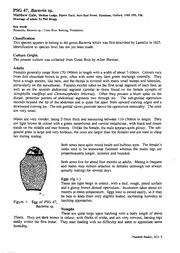
PSG 47, Bacteria sp PDF
Preview PSG 47, Bacteria sp
PSG 47, Bacteria sp, Matthew Gale, Median Lodge, Pipers Yard, Acre End Street, Eynsham, Oxford, 0X8 IPE, UK. Drawings of adults by Phil Bragg. Key words Phasmida, Bacteria sp., Costa Rica, Rearing, Foodplants, Classification This species appears to belong to the genus Bacteria which was first described by Latreille in 1825. Identification to species level has not yet been made. Culture Origin The present culture was collected from Costa Rica by Allan Harman. Adults Females generally range from 170-190mm in length with a width of about 7-10mm. Colours vary from dull chocolate brown to grey, often with some very faint green markings ventrally. They have a rough texture, like bark, and the thorax is covered with many small bumps and tubercles, particularly on the mesothorax. Females exhibit lobes on the first tarsal segment of each foot, as well as on the seventh abdominal segment (similar to those found on the female nymphs of Acrophylla wuelflngi and Ctenomorphodes briareus). Often they possess a blunt spine on the dorsal, posterior portion of abdominal segments two through six. The sub-genital operculum extends beyond the tip of the abdomen and is quite flat apart from upward curving edges and a downward curving tip. The sub-genital valves protrude above the operculum noticeably. The cerci are very small. Males are very slender, being 2-3mm thick and measuring between 110-130mm in length. They are light brown in colour with a green mesothorax and ventral metathorax, with black and cream bands on the middle and rear femora. Unlike the female, the male appears quite glossy. The sub- genital plate is large and very bulbous, the cerci are larger than the females and are used to clasp her during mating. Both sexes have quite round heads and bulbous eyes. The female’s limbs tend to be somewhat flattened whereas the males legs are proportionately longer, slimmer and rounded. Both sexes live for about four months as adults. Mating is frequent and males may remain attached to females (although not always actually mating) for several days. Eggs (fig 1.) These are light beige in colour, with a dull, rough, pitted surface and a glossy brown domed operculum. Incubation takes about six months at room temperature. Eggs tend to mould easily, so it may be best to keep them only slightly humid, increasing humidity as Figure 1. Egg of PSG 47, hatching approaches. Bacteria sp. Nymphs These are quite large upon hatching with a body length of about 25mm, They are dark brown in colour, with flecks of white, and are very nervous, loosing legs easily within the first instar. They start feeding with no difficulty and seem to appreciate some humidity. Phasmid Studies^ 1(1): 5 y PSG 47, Bacteria sp. ! 10cm Phasnud Studies 1(1); 6 PSG 47, Bacteria sp. As they grow, they assume many different shades of brown, some appear to be a rich chestnut colour. Nymphs often possess two horns on their heads but seem to loose these progressively as they mature. Foodplants Bramble, Rose, Hawthorn and Oak are all accepted readily. General comments A placid species with no real active defences. Adult females may produce a frothy liquid from their mouths ifthey feel really threatened. Both sexes tend to thrash around when handled, females often calm down when given something to hold onto, males can’t be calmed and will storm around their cages for some time after being handled. Nymphs sometimes appear to have trouble extracting their legs from the exuviae during moulting, however this is generally a very easy species to keep. Phasmid Studies^ 1(1): 7
